Evolution
Spelvoorbereiding
With /join 2-5 players can start in the game. With /start the game begins. In this case you can also use the Spel tool!
Het spel
The players try to ensure the survival of their animal species by feeding them, increasing the populations, and ensuring their best possible development by increasing their body size and learning new skills. All animals are herbivores that feed on the food supply at the waterhole. They can become carnivores through the trait and then feed on other animal species.
At the end of the game, the players receive points for:
- the food that your own animal species ate during the game,
- the population size of the surviving animal species,
- the number of trait cards of the surviving animal species.
Speelmateriaal
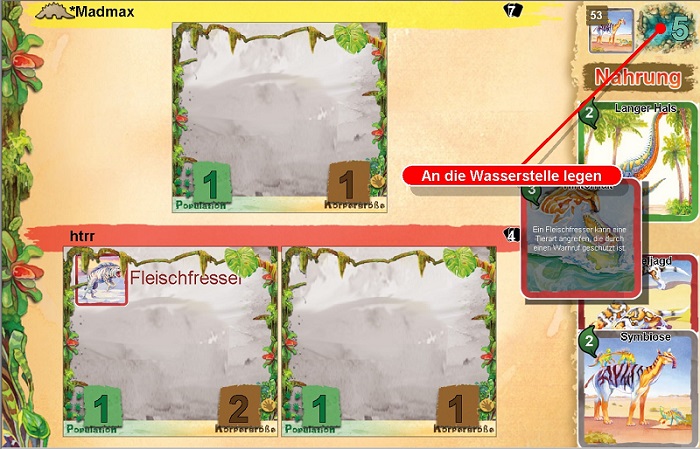
110 cards, 14 of which are carnivores. The other 16 cards are included 6 times each. Food values range from -3 to +9. Animals and food in an unlimited supply.
Spelverloop
One game Evolution is played over several rounds. The end of the game is signaled when the draw pile is used up, and another round is then played. Each round consists of the following phases:
- Receive cards
- Set food offer< /li>
- Play cards
- Before eating
- Eating
- Puntentelling
Kaart
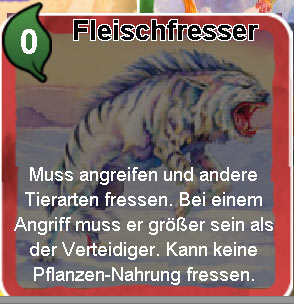
Each card can be used for all of the above actions. Each card shows in the upper left corner the amount of food it provides when played as a food card. The image and its name indicate the property that the cards give the animal when played as a property to an animal
Receive cards
At the beginning of each round, the players receive 3 face down attribute cards and an additional 1 for each animal type in front of them.
Determine food supply
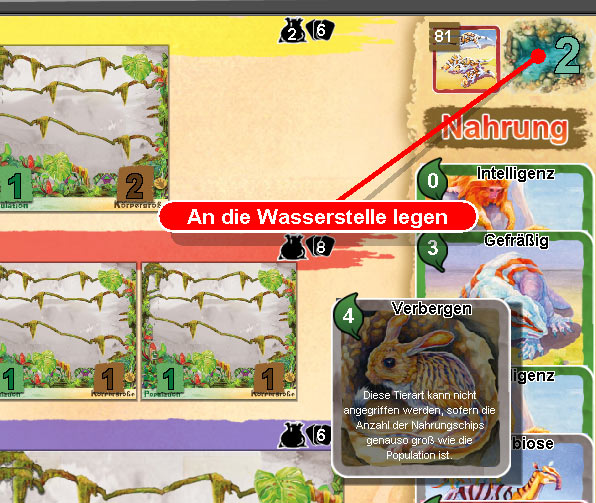
The players simultaneously choose a card from their hand and place it face down on the water hole. These food cards determine how much plant food is available this round. However, they are only revealed at the beginning of the eating phase. Until then, only any remaining food from the previous round will be displayed.
Kaarten spelen
Starting with the starting player and then moving clockwise, each player takes one turn and can then play as many characteristic cards as they want. Cards not played are kept in the hand for the next round.
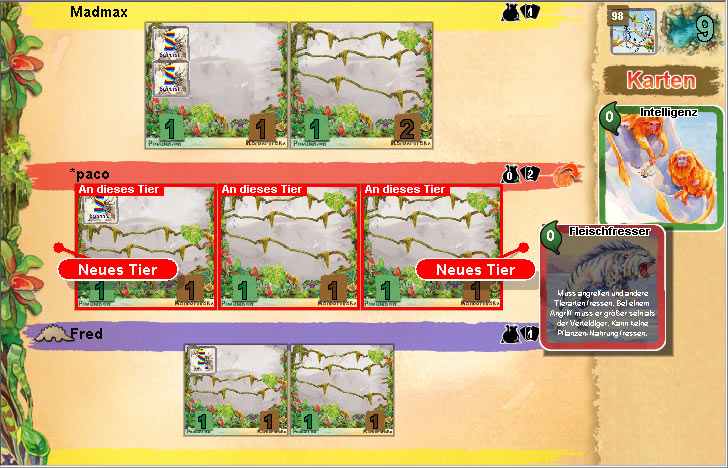
A player can perform one of the following 3 actions per card:
- Get a new animal species
- Increase body size or population
- Play a trait
To play a new animal species to the left or right of existing species, the player simply clicks the corresponding button after selecting the card. No new animal can be placed between the existing animals.
To carry out one of the other two actions, the player first chooses the desired animal after choosing the card. < /p> 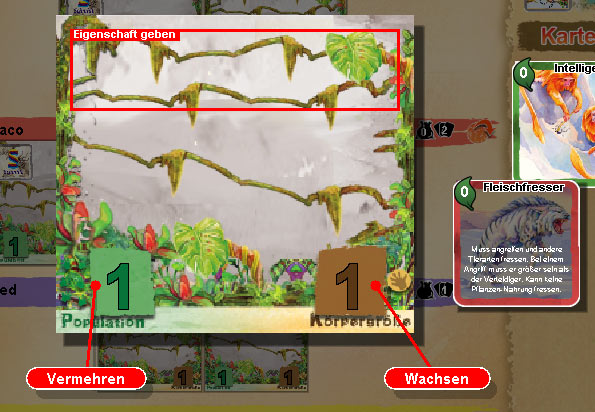
To increase the body size or population, he then clicks the corresponding button at the bottom left or right of the animal map.
To increase a To play a trait, a player clicks on the framed area in the middle of the card. An animal type may have a maximum of 3 properties (with 2 players a maximum of 2 cards) and may not have the same property twice. If a player wants to assign a new property to an animal type that already has the maximum number of cards on display, he must build on one of the existing properties.
Before eating
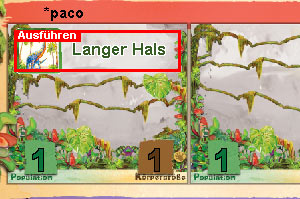
Now the food cards are revealed and the food supply is adjusted accordingly. If the resulting sum is negative, no food comes into play.
Animals with the properties
- Long neck
- Fertility
- Fat layer
- Intelligence (only as a herbivore)
these can now start with Insert starting players by clicking on them. The executable cards are marked. In order to use the intelligence, you must first mark one of the cards in your hand for discarding.
Eat
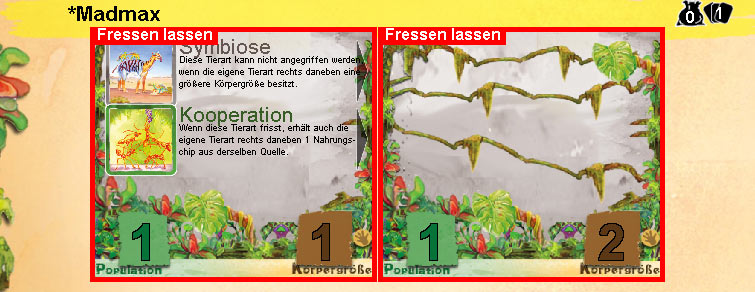
Starting with the starting player, all players must now feed any of their hungry animal species by clicking on it. As a result, it receives one or more food chips due to additional properties. Important: Feeding is repeated in turn until all of the players' animal species are no longer hungry or can no longer be fed due to a lack of food. An animal species is hungry until the number of food chips corresponds to the size of the population. If a player has fed all of his animal species, he will be skipped for further feeding and the remaining players will continue to feed in turn without him.
Feeding herbivores
Basically every animal species is a herbivore. To feed them, all you need to do is click on the animal. They get their food from the supply at the waterhole, which is shown at the top right. Some traits (like Gluttonous) affect the amount of food a player can take from the waterhole. Only with the fat layer can an animal species receive more food chips than the associated population requires.
Feeding carnivores
Carnivores also have to eat while they are still hungry. However, they never eat plant foods, even with the help of traits such as long necks or cooperation. They eat by attacking other animal species. As long as carnivores are not full, they will continue to attack even after the plant food at the waterhole has run out. If necessary, a player must also attack their own animal species. An attack can always be carried out successfully if the body size of the carnivore is larger than the body size of the attacked and the carnivore has characteristics that eliminate the defensive properties of the animal species being attacked. All attackable animals are marked after selecting a carnivore, and a click then carries out the attack. After a successful attack, the population of the animal species attacked is reduced by 1. If the population falls below 1, the animal species is extinct (see extinction). The carnivore then receives as much food as corresponds to the body size of the animal being attacked. Of course, this does not reduce the supply of plant food.
A carnivore can override other animals by using its intelligence properties. To do this, he selects a card from his hand, activates intelligence and then clicks on the desired property. This is now deactivated for ALL animal species until the attack occurs. Of course, this only applies to this carnivore, which is therefore marked green.
It should also be noted that a carnivore NEVER eats plant food, but a herbivore does, for example, through the trait of scavenger or Cooperation can also eat meat.
End of feeding
The feeding ends when all of the players' animal species have eaten enough food that the number of food chips corresponds to the size of their population or when no hungry animal species can take in more food. If a species was unable to eat enough food, the population of that species is reduced to the number of food chips present. If an animal species has not eaten any food, the population size drops to 0 (the animal species dies out - see extinction). All food chips that are still on the water hole after feeding remain there for the next round. Every player who no longer has an animal type receives a new one from the supply for free. All food chips are removed from the animal species and count as victory points at the end of the game. You can see your current number in your status bar on the right side of the bag. The next player becomes the new starting player and receives the starting player marker.
Extinction
< span>If the population of an animal species drops to 0, it is extinct and will be removed immediately. All food chips that are still on the extinct animal species also count as points at the end of the game. All adjacent property cards are thrown face-up onto the discard pile. The player immediately receives as many new cards as were on display for the extinct animal species. If an animal species that was between two other animal species dies out, the remaining animal species collapse. So there are no gaps.
Speleinde
Is the draw pile When the cards are used up, the discard pile is shuffled and laid out as a new draw pile. This signals the end of the game: If the discard pile has to be reshuffled during the dealing phase, this is the beginning of the last round. The game then ends after eating. If the discard pile is shuffled in another phase of the game, this round is played to the end first and then a complete round is played. Only then will the scoring take place. The last round is indicated by the bell on the draw pile.
Telling
< span>The players receive victory points at the end of the game as follows:
- 1 victory point for each food chip eaten in the game.
- for the population size of each survivor Animal species 1 victory point per level
- 1 victory point for each characteristic card that is adjacent to the surviving animal species board.
The player with the most points wins.
Tiebreaker
If there are multiple players with the same score, is the number of trait cards of the surviving animal species is the first tiebreaker.
Second tiebreaker is the sum of the populations of the surviving animal species.
Card overview
A list of all 17 properties with explanations can be found in the original instructions from page 6 can be viewed.

